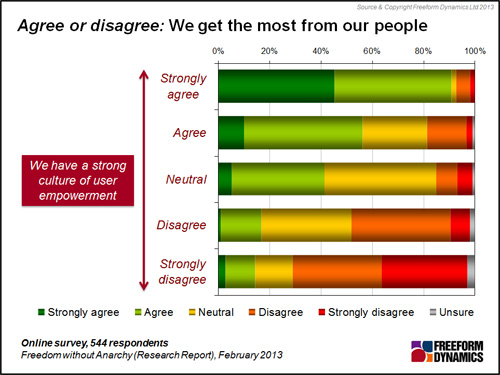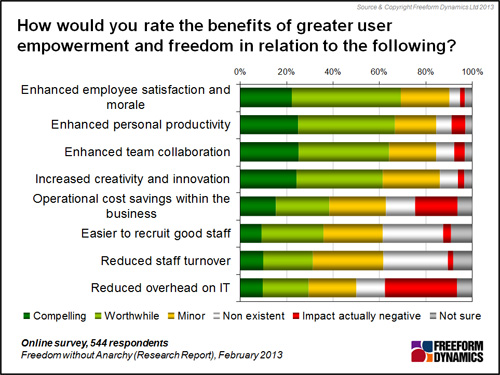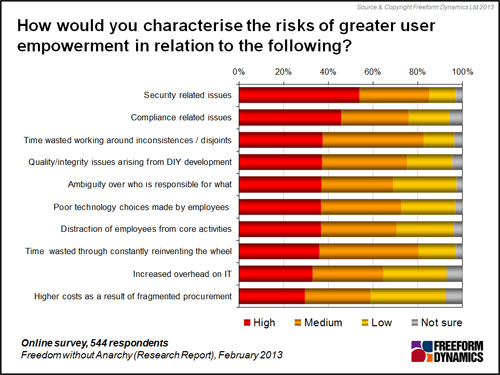By Tony Lock
Many organisations say their people are among the most valuable assets they have. Whilst this statement is entirely accurate, providing the best working conditions and tools that allow the people to flourish is anything but an exact science. Empowering users to be creative holds great potential to help organisations quickly exploit new opportunities, but with much of business now dependent on the use of IT systems and personal productivity tools, ‘enabling’ a workforce can also entail risk. Do the benefits achievable justify the effort in combating such risks?
Freeform Dynamics recently ran an online survey to investigate user empowerment, the full results of which can be found here, 544 respondents, mostly IT professionals or power users based in the UK, Scandinavia and the DACH region gave us their thoughts.
Many IT vendors today stress the rise of Bring Your Own Device (BYOD) as an example of user empowerment, but real benefits arise only when the right culture and mindset are developed. Relying simply on new access devices and technology fashions is not the whole picture. For user empowerment to be successful it is important that end to end IT solutions be put in place to permit users to make business decisions effectively. But, and it’s a very big but, the organisation also needs to ensure that users can act rapidly on such decisions.
As the chart below shows, organisations that have a strong culture of user empowerment believe they are very good at harnessing the skills and business capabilities of their people.

But what, precisely, are the benefits delivered by empowering users? As can be seen from the chart below, few of the benefits potentially available through user empowerment are perceived to be compelling by more than a sizable minority of respondents. That said, it is clear that many benefits are deemed to be worthwhile. People related benefits are particularly well represented; factors such as improving employee morale, enhancing productivity and increasing creativity and innovation are recognised by significant numbers of respondents. Such advantages are very difficult to quantify in budgetary terms, but usually represent very good value in terms of generating new business, higher quality work etc.

It is interesting to note that benefits such as making it easier to recruit and keep staff, things with which BYOD is heavily associated, lag far behind. Indeed, considerable doubt is reported by a sizeable proportion of respondents that such benefits exist at all.
Of the inherently more ‘quantifiable’ benefits, it should be noted that two areas are ranked by significant numbers as actually having a negative impact. Both concern the financial impact of user empowerment on IT.
It is clear a broad range of worthwhile benefits can be achieved through empowering users more effectively. So what, apart from developing a suitable ‘culture’, is holding things back? In terms of technology, the respondents, many of whom may well be early adopters of the trends discussed, indicate there are risks to be addressed.

As might be expected from a largely IT specialist respondent base, security and compliance feature very highly amongst perceived risks. Quality issues arising from DIY solutions are also perceived to be potential problems. Many of the other factors mentioned are also close to the heart of IT professionals as they relate to the potential for time to be wasted, especially via increased support burdens. The possibility that end user productivity could be negatively impacted also gets a more than honourable mention.
The chart also indicates that enabling user empowerment could raise IT overheads as well as costing the organisation more via fragmented procurement. In times when the global economic situation is delicately balanced and all business budgets are under extreme scrutiny, these are factors that cannot be ignored.
Tackling these issues leads once again back to the nature of the underlying infrastructure required to deliver flexible services. This is especially important given that not all users have the same needs and skills. Together with comprehensive, yet flexible core IT enabled business systems, highly empowering organisations also tend to provide a more versatile set of productivity tools and are far more likely to provide users with smartphones and tablets.
But again, it all comes back to ‘management’. Organisations with a well enabled workforce need comprehensive management tools and processes to handle user driven activity. But good tools alone cannot support anything and everything. Even in organisations that actively empower their employees, users must understand that there are limits on their freedom.
To sum up it all up, technology has a major role to play in empowering users, but solutions must be well thought out and planned, with appropriate resources made available. BYOD and other ‘empowerment’ initiatives cannot be implemented safely on a zero or negative budget.
CLICK HERE TO VIEW ORIGINAL PUBLISHED ON

Tony is an IT operations guru. As an ex-IT manager with an insatiable thirst for knowledge, his extensive vendor briefing agenda makes him one of the most well informed analysts in the industry, particularly on the diversity of solutions and approaches available to tackle key operational requirements. If you are a vendor talking about a new offering, be very careful about describing it to Tony as ‘unique’, because if it isn’t, he’ll probably know.



Have You Read This?
Generative AI Checkpoint
From Barcode Scanning to Smart Data Capture
Beyond the Barcode: Smart Data Capture
The Evolving Role of Converged Infrastructure in Modern IT
Evaluating the Potential of Hyper-Converged Storage
Kubernetes as an enterprise multi-cloud enabler
A CX perspective on the Contact Centre
Automation of SAP Master Data Management